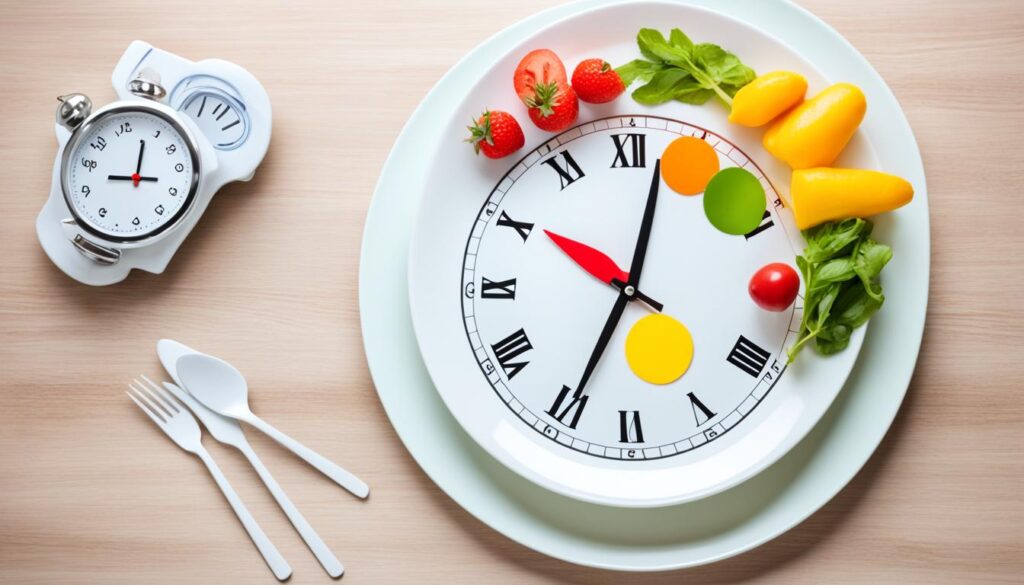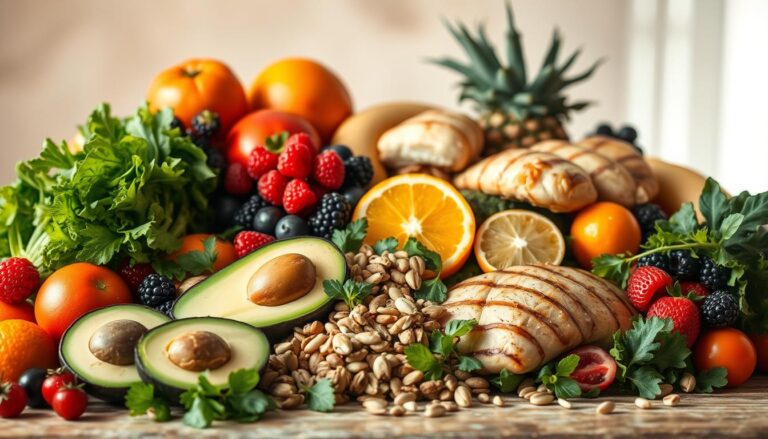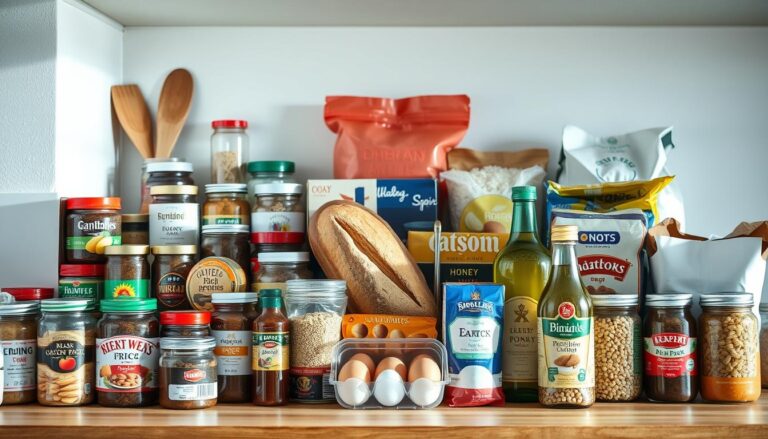Are you tired of fad diets and unsustainable weight loss plans? Look no further! This guide will show you how to lose fat safely and effectively. You’ll learn about calorie deficits clean eating, and exercise routines that work.
These strategies will help you change your body and keep the results for good.
Key Takeaways
- Understand the calorie deficit equation for sustainable fat loss
- Learn how to boost your metabolism through clean eating and nutrient-dense foods
- Discover the benefits of intermittent fasting and how to incorporate it into your lifestyle
- Harness the thermogenic effects of exercise including high intensity interval training
- Maintain lean muscle mass during your fat loss journey for a toned, sculpted physique
Mastering the Calorie Deficit Equation
Achieving lasting fat loss isn’t about quick fixes or fad diets. It’s about understanding energy balance and creating a calorie deficit that lasts. We’ll explore the science behind your metabolic rate and share strategies for a calorie deficit that helps with weight management. This approach ensures you don’t lose energy or health.
Understanding Your Metabolic Rate
Your metabolic rate is how many calories your body burns when you’re not moving. It’s key to managing your weight. Things like your age, gender, muscle mass, and activity level affect your metabolic rate. Knowing this helps you set the right calorie intake and exercise plan for fat loss and a healthy body.
- Basal Metabolic Rate BMR: This is the minimum calories your body needs to work at rest.
- Total Daily Energy Expenditure TDEE: This includes your BMR plus calories burned from daily activities and exercise.
- Measuring Metabolic Rate: Tools like body composition analysis, indirect calorimetry, and wearable technology can help you figure out your metabolic rate.
Creating a Sustainable Calorie Deficit
To lose fat you need to burn more calories than you eat. But, it’s important to find the right balance to keep your health and energy up.
- Determine Your Calorie Needs: Use your TDEE to find the right daily calorie intake for your weight loss goals.
- Establish a Moderate Deficit: Aim for a calorie deficit of 500-750 calories a day. This can lead to losing 1-2 pounds a week.
- Monitor and Adjust: Keep an eye on your progress and change your calorie intake or exercise as needed to keep the deficit.
The key to successful, long-term fat loss is creating a calorie deficit that’s just challenging enough to drive progress, but not so extreme that it becomes unsustainable. Nutrition Expert Sarah Johnson

Understanding your metabolic rate and keeping a sustainable calorie deficit will help you reach your fat loss goals. This approach keeps your health and well being a top priority.
The Power of Clean Eating for FAT LOSS
Clean eating is a strong way to lose fat. It focuses on whole unprocessed nutrient-dense foods. This helps with weight management boosts your metabolism, and improves your body composition.
Nutrient Dense Foods for Weight Management
Adding clean eating habits to your life can really help. Say no to processed foods and choose nutrient-dense ones instead. These foods are full of vitamins, minerals, and fiber. They help control cravings give you energy, and support your weight management goals.
- Lean proteins, such as chicken, turkey, and lean cuts of red meat, to support muscle growth and maintenance.
- Leafy greens and other vegetables, which are low in calories but high in fiber and essential nutrients.
- Whole grains, like quinoa, brown rice, and oats, to provide complex carbohydrates that fuel your body.
- Healthy fats, such as avocados, nuts, and olive oil, to support hormone production and brain function.
- Berries and other low-sugar fruits, which offer a sweet treat without the blood sugar spike.
By eating these nutrient-dense foods, you feed your body well. You’ll feel less hungry, support your metabolism, and move closer to your fat loss goals.
Clean eating is not a diet, but a lifestyle choice that can have a profound impact on your health energy levels and body composition. – Nutrition Expert Jane Doe

Macronutrient Balancing Act
Getting rid of fat requires a balance of protein, carbs, and fats. Getting the right mix of these nutrients helps with weight loss and keeps muscle mass. We’ll look at how to balance your macronutrients for effective fat loss.
Protein The Building Blocks of Muscle
Protein is key for keeping muscle mass, which is vital for a toned look. When you eat less calories, protein helps keep muscle and supports your body composition goals. Try to eat 0.7 to 1 gram of protein for every pound of your weight to keep muscle while losing fat.
Carbohydrates Fuel for Your Workouts
Carbs give your body energy, making them crucial for your workouts and weight control. Choose clean eating carbs like whole grains, fruits, and veggies for lasting energy and balanced macronutrients.
Fats The Forgotten Macronutrient
Healthy fats are not bad for losing fat. They help with hormone balance, brain function, and fat burning. Go for unsaturated fats in foods like avocado, nuts, and olive oil for the best macronutrient mix.
| Macronutrient | Recommended Range % of Total Calories | Benefits for Fat Loss |
|---|---|---|
| Protein | 20-35% | Preserves lean muscle mass, supports metabolism |
| Carbohydrates | 40-50% | Provides energy for workouts, supports glycogen stores |
| Fats | 20-30% | Regulates hormones, supports brain and heart health |
Finding the right macronutrient mix is personal. Try different ratios and watch how your body responds to find what’s best for your body composition and weight management goals.

Proper macronutrient balance is the key to unlocking your fat-burning potential and achieving a sculpted, healthy physique.
Intermittent Fasting A Time-Efficient Approach
Intermittent fasting is now a big deal for losing weight and boosting metabolism. It’s a simple way to get healthier without spending a lot of time. Many people find it changes their health and fitness for the better.
Benefits of Intermittent Fasting
Intermittent fasting has lots of perks for those wanting to lose weight and feel better. It helps create a calorie deficit which can speed up your metabolism. It also helps with weight management and can change your body composition for the better. Plus, it’s linked to better insulin use, less inflammation, and more cell repair.
Different Fasting Protocols
There are many ways to do intermittent fasting, depending on what you like and your schedule. Here are some popular ones:
- 16/8 Method: Fast for 16 hours and eat during an 8-hour window.
- 5:2 Diet: Eat normally for 5 days and cut calories to 500-600 for 2 days.
- Alternate-Day Fasting: Fast for 24 hours then eat normally for 24 hours.
- Eat-Stop-Eat: Fast for 24 hours, 1-2 times a week, and eat normally the rest of the time.
These options let you pick what works best for you, making it easier to stick with intermittent fasting. It’s a great way to lose fat in a healthy way.

Adding intermittent fasting to your weight loss plan can really help. It’s a smart way to lose fat without giving up your life. It opens up new paths to reaching your fitness goals while keeping you healthy.
Unleash the Thermogenic Effects of Exercise
Exercise is key to reaching your fat loss goals. Some workouts have a strong thermogenic effect, helping you burn more calories and boost your metabolism. We’ll look at the power of high-intensity interval training HIIT as a tool against unwanted fat.
High Intensity Interval Training HIIT
HIIT switches between intense activity and rest or low-intensity exercise. It’s great for increasing metabolism, burning calories, and improving body composition. HIIT works by boosting a process called thermogenesis, keeping your body burning calories even after you stop exercising.
HIIT workouts push you hard, making your muscles work harder and your heart rate go up. This intense effort keeps your metabolism high for hours after exercise. So, you’ll burn more calories all day, leading to a bigger calorie deficit and better fat loss.

HIIT is also very efficient with time. These workouts are short, lasting 15-30 minutes. This makes them perfect for busy people. By adding HIIT to your routine, you can make the most of your workout time and see great results quickly.
To start with HIIT, try exercises like sprinting, cycling, or bodyweight exercises like burpees or jump squats. Aim to push yourself hard during intense intervals and rest when needed. Try different HIIT routines to find what suits you and your goals best.
Preserving Lean Muscle During FAT LOSS
Keeping a healthy lean muscle mass is key when losing fat. Lean muscle boosts your body composition and helps your metabolism, so you burn more calories even when resting. We’ll look at ways to keep your muscle while losing fat.
Resistance Training for Muscle Maintenance
To keep lean muscle while losing fat, add regular resistance training to your workouts. These exercises help your muscles grow and stay strong. This way, you keep the lean muscle you worked hard for.
- Do exercises that work many muscles at once, like squats, deadlifts, and bench presses.
- Slowly increase the weight, reps, and intensity of your resistance training to push your muscles to grow.
- Make sure to rest and recover well between workouts so your muscles can repair and rebuild.
By focusing on resistance training, you can keep your lean muscle while losing fat. This leads to a toned and sculpted look.
| Exercise | Muscles Targeted | Benefits for Fat Loss |
|---|---|---|
| Squats | Quadriceps, Glutes, Hamstrings | Increases metabolism and lean muscle mass in the lower body |
| Deadlifts | Back, Hamstrings, Glutes | Builds lean muscle and enhances whole-body strength |
| Bench Press | Chest, Shoulders, Triceps | Develops upper body muscle and boosts metabolic rate |
Maintaining lean muscle mass is essential for long-term fat loss success. Strength training helps preserve your metabolic rate and supports a healthy body composition.
Strategies for Boosting Your Metabolism
Your metabolism is key to losing fat and managing weight. Knowing how to boost your metabolic rate can help you change your body for the better. We’ll look at ways to make your metabolism work better and help you burn more fat.
The Thermogenic Power of Superfoods
Some foods can make your metabolism faster by increasing thermogenesis. These foods are great for boosting your metabolism:
- Spicy peppers, like cayenne or chili peppers, have capsaicin to help your metabolism
- Green tea is full of catechins that boost your metabolism and burn fat
- Protein-rich foods like lean meats, eggs, and legumes make your body work harder to digest and process them
Eating these foods every day can really help you burn more fat.
Supplement Your Way to a Faster Metabolism
Some supplements can also help speed up your metabolism. Good ones for metabolism include:
- Caffeine makes you more energetic and helps burn fat
- Omega-3 fatty acids improve your metabolism and body shape
- L-carnitine helps move fatty acids to your mitochondria for energy
With a good diet and exercise, these supplements can help you lose fat and manage your weight better.
Lifestyle Habits that Ignite Your Metabolism
There are lifestyle changes that can really help your metabolism too. These are some:
- Doing regular resistance training builds lean muscle, which helps your metabolism
- Getting enough sleep is important because not sleeping well can slow down your metabolism
- Drinking enough water is important because not drinking enough can slow down your metabolism
Adding these lifestyle changes can make your body burn fat better.
| Metabolic-Boosting Strategies | Key Benefits |
|---|---|
| Thermogenic Superfoods | Increased calorie burn, enhanced fat oxidation |
| Metabolism-Boosting Supplements | Elevated energy expenditure, improved body composition |
| Lifestyle Habits | Increased lean muscle mass, optimized hormone balance, improved hydration |
Using these strategies to boost your metabolism will help you reach your fat loss and weight management goals. A complete approach that includes diet, supplements, and lifestyle changes is best for boosting your metabolism.

A faster metabolism is the Holy Grail of weight management. By understanding how to optimize your metabolic rate, you can unlock the door to sustainable fat loss and a healthier body composition.
Navigating the Ketogenic Diet
The ketogenic diet is a popular choice for losing fat and managing weight. It focuses on eating fewer carbs and more fats. This can help your body burn fat naturally, making it a great option for those looking for lasting weight loss.
Potential Benefits of the Ketogenic Diet
One key benefit is entering a state called ketosis. In ketosis, your body uses fat for fuel instead of carbs. This leads to faster fat burning and can help you lose weight and improve your body shape.
Also, the diet can make you feel more full, which might help you eat less. Some research shows it can also help control blood sugar and improve insulin use. This could be good for people with certain health issues.
Potential Drawbacks of the Ketogenic Diet
- Sticking to the diet long-term can be hard because you eat fewer carbs. This might be tough for some people.
- Switching to a ketogenic state can cause side effects like feeling tired, having headaches, and stomach issues. This is often called the keto flu.
- There’s a lot of debate about the safety of the diet over time. Some worry about its effects on people with certain health problems or those taking certain medicines.
Thinking about the ketogenic diet? Weigh its good points against the bad. Always talk to a doctor to see if it fits your health goals and situation.
| Potential Benefits | Potential Drawbacks |
|---|---|
| Induces ketosis, leading to efficient fat-burning | Can be challenging to sustain long-term |
| Enhances satiety and reduces calorie intake | Transitioning to ketosis can cause temporary side effects |
| May improve blood sugar regulation and insulin sensitivity | Ongoing debate about long-term safety and risks |
Choosing the ketogenic diet? Make sure you know its pros and cons, and how it fits with your health and weight goals.
Mindful Eating A Key to Sustainable Results
Getting lasting fat loss is more than just diet and exercise. Mindful eating is key to keeping weight off and feeling good. We’ll see how eating mindfully can change your fat loss path.
Mindful eating means eating with full attention. It’s about eating slowly, enjoying each bite, and noticing how food makes you feel. This way, you can stop eating because you’re bored or stressed. It helps you build habits that keep you at a healthy weight.
- Recognize hunger and fullness cues: Pay attention to when you’re hungry or full. Don’t eat because you’re bored or upset.
- Eliminate distractions: Don’t eat in front of the TV or while on your phone. Eating without distractions helps you enjoy your food more.
- Slow down and savor: Chew your food well and enjoy its taste and texture. This makes you feel fuller and helps you eat less.
- Practice gratitude: Before eating, think about how lucky you are to have food. This makes you appreciate your meals more.
Using these mindful eating tips helps you lose fat for good and love food more. Remember, real change starts inside. Mindful eating is a great way to meet your weight management goals and live a clean eating life with healthy habits.
Mindful eating is not a diet, it’s a way of living and being. It’s about cultivating a deep appreciation for the food that nourishes our bodies and souls.
FAT LOSS and Body Composition
Weight management isn’t just about the number on the scale. It’s about understanding your body composition the mix of fat and lean muscle. Keeping an eye on this can help you see how well your fat loss plans are working. It lets you make changes to get the body you want.
Measuring Body Fat Percentage
Measuring your body fat percentage is a key way to check your body composition. This gives you a full picture of your health and fitness, not just your weight. There are a few ways to do this, including:
- Skinfold calipers: A simple, affordable tool that measures the thickness of your skin at various points on your body to estimate your body fat percentage.
- Bioelectrical impedance analysis BIA: A more advanced method that uses electrical signals to determine the ratio of fat to lean muscle in your body.
- Underwater weighing: Considered the gold standard for measuring body composition, this technique involves weighing you underwater to determine your body density and calculate your body fat percentage.
- Dual-energy X-ray absorptiometry DEXA scan: A highly accurate, but more expensive, method that uses low-dose X-rays to precisely measure your body’s fat, muscle, and bone composition.
Tracking your body fat percentage over time helps you see how your fat loss efforts are doing. This lets you tweak your diet and exercise to get better results. This way, you can manage your weight better and get a leaner, healthier body.
| Measurement Method | Accuracy | Cost | Convenience |
|---|---|---|---|
| Skinfold Calipers | Moderately Accurate | Low | High |
| Bioelectrical Impedance Analysis BIA | Moderately Accurate | Moderate | High |
| Underwater Weighing | Highly Accurate | High | Low |
| Dual-energy X-ray Absorptiometry DEXA Scan | Highly Accurate | High | Moderate |
Understanding your body composition and tracking your body fat percentage gives you insights to improve your fat loss plans. This helps you reach your fitness goals.
Overcoming Plateaus and Stalls
The journey to lose fat and manage weight isn’t always easy. You might hit plateaus and stalls where your weight doesn’t change, even when you try hard. Don’t worry, we have tips to help you boost your metabolism and see progress again.
First, figure out why you’re stuck. Is your calorie deficit too big, slowing down your metabolism? Have you done the same workouts so long that your body got used to them? Or are you eating more calories than you think? Knowing the cause helps you find the right fix.
Rebooting Your Metabolism
To kickstart fat loss, try a metabolic reset. This means eating a bit more for 1-2 weeks to boost your metabolism. Here’s how:
- For 1-2 weeks, eat 300-500 more calories than usual.
- Eat nutrient-rich, whole foods during this time.
- Keep doing your usual workouts.
- Then, go back to your calorie deficit and watch your fat loss pick up again.
This method gives your metabolism a boost, helping you break through a plateau. Just don’t eat too much – moderation is important.
Mixing Up Your Workouts
Exercise can also cause plateaus if you do the same thing too often. The fix is to periodize your training.
- Switch between HIIT, strength training, and steady cardio every week or month.
- Try new exercises and training methods to keep your body guessing.
- Slowly increase workout intensity, duration, or volume to keep challenging yourself.
Changing things up keeps your body from getting too comfortable, helping you burn fat better.
Remember, beating plateaus and stalls means being flexible. Be open to trying new things, track your progress, and adjust as needed. With the right approach, you can overcome any weight loss hurdle and get the body you want.
Conclusion
In this guide, you’ve started a journey to learn how to lose fat safely and sustainably. You now know how to balance your calories, eat clean, and manage your macronutrients. This gives you the tools to change your body and boost your health.
You’ve also learned how to keep your muscles while losing fat with exercises and resistance training. Your body’s shape shows the healthy habits you follow. With a positive mindset, you can reach your full potential.
Keep moving forward, celebrate your achievements, and believe in the process. Don’t forget to enjoy the small victories, get past any hurdles, and stay dedicated to being healthier and more confident. With these tips, you can control your future and look forward to a better body and life.





